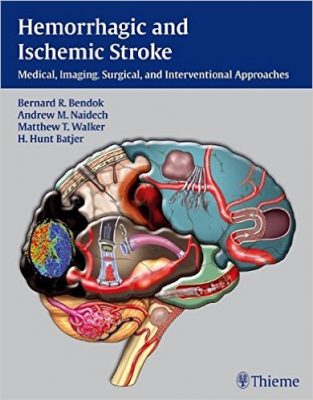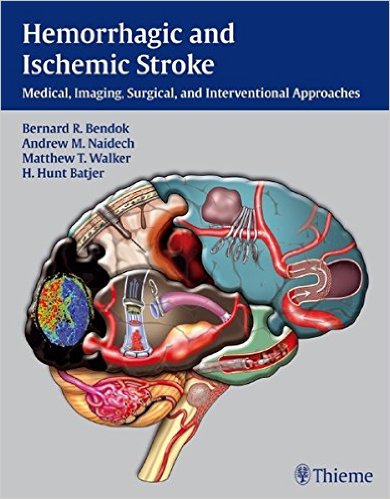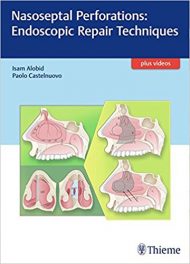 Editors: Bernard R. Bendok, MD; Andrew M. Naidech, MD; Matthew T. Walker, MD; and H. Hunt Batjer, MD
Editors: Bernard R. Bendok, MD; Andrew M. Naidech, MD; Matthew T. Walker, MD; and H. Hunt Batjer, MD
Publisher: Thieme – 557 pages
Book Review by: Nano Khilnani
According to 2015 statistics of the Centers for Disease Control, almost 130,000 people in the United States die from strokes each year. This works out to one death every four minutes. More than 795,000 have a stroke annually, and of these, 610,000 or more than three quarters of them are first-time occurrences.
Stroke is the fifth leading cause of death for people in the U.S. Almost two–thirds of all stroke victims are those over 65 years of age, but the risk factors (high blood pressure being the leading one) develop over the years before reaching that age.
A stroke is basically a brain attack. Medically termed as a cerebrovascular accident or a CVA, or cerebrovascular insult or a CVI, it is when poor blood flow to the brain results in cell death. The two main types of stroke are: ischemic, due to lack of blood flow, and hemorrhagic, due to bleeding, which can cause severe headaches. About 87 percent of all strokes are ischemic. Stroke symptoms can be permanent and the recovery process is quite prolonged.
Both types of strokes result in part of the brain not functioning fully. Some signs and symptoms of a stroke may include:
- Inability to move one side of the body (depending where in the brain the stroke occurred)
- Problems in comprehending language orspeaking
- A head-spinning sensation
- Loss of sight on one side
Symptoms often appear soon after a stroke has occurred. If symptoms last less than one or two hours it is known as a transient ischemic attack, or TIA as an acronym. We have not checked the statistics on the numbers of stroke victims who remain partially disabled for life, but it is our assumption that there are hundreds of thousands, or possibly millions of them.
This book on hemorrhagic and ischemic strokes is the combined work of 114 specialists including the editors. Their specializations are mainly in neurology, neuroradiology, neurosurgery, neurovascular surgery, and radiology. But some are in anesthesiology as well. They wrote the 40 chapters of this book with the expert guidance of the four editors named above.
Almost all contributors are from the United States, except a few from Finland, the Netherlands, and Turkey. The chapters of this book are divided into four Sections, which are:
- Medical and Critical Care Considerations
- Imaging Considerations
- Open Surgical Approaches
- Neurointerventional Approaches
Besides the content found in the print version, you can also view the following 10 videos (and much more) available online to you as purchaser of this book:
- Decompressive craniectomy for stroke (chapter 16)
- Carotid aneurysm clip reconstruction (chapter 20)
- Microsurgical treatment of ruptured right posterior communicating-internal carotid artery aneurysm (chapter 21)
- Extracranial-intracranial bypass (chapter 22)
- Giant thrombosed aneurysm (chapter 22)
- Arteriovenous malformation (AVM) surgery (chapter 23)
- Excimer laser-assisted non-occlusive anastomosis (ELANA) bypass technique (chapter 29)
- Aneurysm coiling (chapter 35)
- Cranial AVM embolization
- Spinal AVM and dural fistula embolization
These videos illustrate the principles and techniques of surgical and neuroendovascular procedures used for treating stroke patients.
To view these videos, visit www.MediaCenter.Thieme.com and, when prompted during the registration process, enter the scratch-off code available on the first page of this book.
This is also a valuable resource:
Video Atlas of Intracranial Aneurysm Surgery
http://www.thieme.com/books-main/neurosurgery/product/1745-video-atlas-of-intracranial-aneurysm-surgery
Each chapter of this book begins with a colored box named Pearls with bullet point of key information.
The material in the each chapter is neatly organized with concise presentations of topics and subtopics of discussion. The textual material is oftentimes accompanied by graphics to make learning, understanding, remembrance and retention of points easier. Pie charts, graphs, and tables with data abound throughout the book to illustrate what is written in the text blocks.
Full-color photos as well as scans of blocked blood flows in arteries – taken through angiography, computed tomography (CT), computed tomography (CTA), magnetic resonance imaging (MRI) and other modalities – point out aneurysms, embolisms, hemorrhages, and other problems.
A Conclusion provides a capsule of the subject covered in each chapter, and the chapter ends with a large list of References for further exploration and study of various topics.
This is an excellent, highly valuable, as well as practical book on hemorrhagic and ischemic strokes, highlighting medical, imaging, surgical, and interventional approaches. It is authoritative, with an extensive amount of well-documented, evidence-based information that is well organized and presented, with detailed discussions of critical issues.
Editors:
Bernard R. Bendok, MD, FACS is Associate Professor of Neurological Surgery and Radiology at Northwestern University Feinberg School of Medicine in Chicago, Illinois.
Andrew M. Naidech, MD, MSPH is Associate Professor in the Department of Neurology, Anesthesiology, and Neurological Surgery at Northwestern University Feinberg School of Medicine in Chicago, Illinois.
Matthew T. Walker, MD is Associate Professor of Radiology and Chief of Neurosurgery at Northwestern University Feinberg School of Medicine in Chicago, Illinois.
Hunt Batjer, MD, FACS is Michael J. Marchese Professor of Neurological Surgery, Professor and Chair of the Department of Neurological Surgery at Northwestern University Feinberg School of Medicine in Chicago, Illinois.
Forewords:
Medical and Critical Care Considerations:
Sheryl Martin-Schild, MD, PhD is a vascular neurologist who is Assistant Professor of Neurology, and Director of the Stroke Program at Tulane University School of Medicine in New Orleans, Louisiana.
Imaging Considerations:
Max Wintermark, MD is Associate Professor of Radiology, Neurology, Neurological Surgery, and Biomedical Engineering, and Chief of Neuroradiology at the University of Virginia in Charlottesville, Virginia.
Open Surgical Approaches:
Roberto C. Heros, MD is Professor and Co-Chairman of Neurological Surgery, and Resident Program Director at the University of Miami in Miami, Florida.
Neurointerventional Approaches:
Jacques Dion, MD, FRCP (C) is Professor and Head of the Division of Neuroradiology, and Professor of Neurosurgery at Emory Clinic in Atlanta, Georgia.







